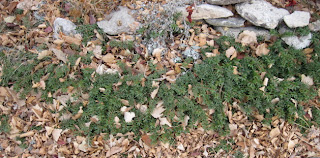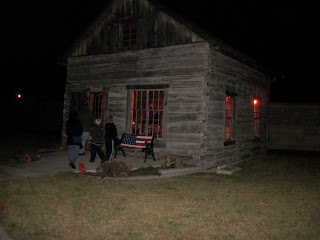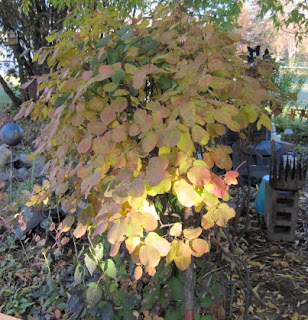This plant was purchased at Bakers in Fargo for $3.99.
(dick’ ea)
Dyckias, are generally one of the most cold hardy of all of the
Bromeliad genera.
Dyckia is one of the genera in the subfamily Pitcairnioideae. This
subfamily contains some of the most primitive Bromeliad species. Most
Pitcairnioideae genera are saxicolous (living on or around rocks) or
terrestrial (growing in the ground). The majority of the
approximately 120 different species of Dyckia are native to central
Brazil, with some being found in Uruguay, Paraguay, Argentina, and
Bolivia. Most are found growing among rocks in warm sunny areas ranging
in altitude from sea level to 2000 meters.
The genus was introduced into Europe during the nineteenth century,
and was named for Prince von Salm-Dyck, an early expert on succulents.
Although Dyckias have no internal water storage tissue like true
succulents, they are xerographic and survive long periods without water
by going dormant. Their rosette of thick succulent leaves will
eventually wilt, but recovery is rapid when watering is resumed.
Although the flowers aren’t large, bees, wasps and hummingbirds find
them attractive. The plants themselves come in a range of colors (green,
rose, maroon, tan, or silver), and a variety of leaf shapes (long and
thin, short and fat, deeply lobed, or almost smooth).
|
Light:
|
They like full sunlight. 5000 foot-candles,
50% shade, is probably the least amount of sun that they can have and
still flourish. |
|
Temperature:
|
They prefer temperatures in the range of 40-90 degrees
Fahrenheit, but they will withstand much lower and higher temperatures. |
|
Fertilizer:
|
Use full a dilute fertilizer solution (¼ strength or
less) with every watering spring through fall, but eliminate fertilizer
during cold weather. When plants are actively growing in strong light,
it is hard to over fertilize an established plant, but they don’t appear
to suffer if they are not fertilized, they just grow more slowly. |
|
Water:
|
Although they will tolerate drought, they thrive on
frequent watering while actively growing, however keep plants on the dry
side during cold weather or during periods of reduced light. In the
summer time they tend to dry out rapidly; it is helpful to keep them in a
shallow container of water. |
|
Medium:
|
Grow in a heavy mix that contains water retaining
polymers and a large quantity of organic matter. |
|
Containers:
|
Dyckias probably do best when they are grown in the
ground. If you do choose to grow them in
pots, use one that will accommodate the plant’s large root system. This
is one plant that appreciates a pot that is about as wide as or wider
than the plant itself. |
|
Propagation:
|
Most Dyckia species have leaves armed with sharp spikes
that make working with the plants painful. It is often difficult to
separate pups from the mother plant. It is helpful to remove the plant
from its pot and try to work on it from the bottom. You want to bring
out the heavy equipment when dealing with your Dyckia collection.
Leather gloves, a sturdy knife, a small saw, and, in extreme cases, a
hatchet could all come in handy when it is time to separate and repot
large clumps of plants. When you separate a pup, try to preserve as much
of its root system as you can. If it has no roots, treat its base with
rooting hormone. |
 Pachistima canbyi
Pachistima canbyi Chorizo cheese ball
Chorizo cheese ball Green's Girls Christmas Party 2011
Green's Girls Christmas Party 2011
 Dyckia
Dyckia

 The hypertufa studio is decorated for Christmas.
The hypertufa studio is decorated for Christmas. Then the Christmas decoration inspector comes along.
Then the Christmas decoration inspector comes along.


 Juneberry is turning color for fall.
Juneberry is turning color for fall. Hostas are down because of a hard frost. Pulmonaria and heuchera are still OK
Hostas are down because of a hard frost. Pulmonaria and heuchera are still OK







 Bleeding Heart
Bleeding Heart 99 cent basket of impatiens from a sale last fall
99 cent basket of impatiens from a sale last fall
 Plants 2011
Plants 2011 BIRDS AND BUTTERFLIES AT THE BELLAGIO
BIRDS AND BUTTERFLIES AT THE BELLAGIO

 Bellagio Hotel & Casino
Bellagio Hotel & Casino


 Seeds are being planted.
Seeds are being planted. Calamagrostis x acutiflora 'Karl Foerster
Calamagrostis x acutiflora 'Karl Foerster Clif brought in lots of his metal art for the Olli class.
Clif brought in lots of his metal art for the Olli class.


 Rosa glauca or rosa rubifolia
Rosa glauca or rosa rubifolia 
 Calamagrostis
Calamagrostis